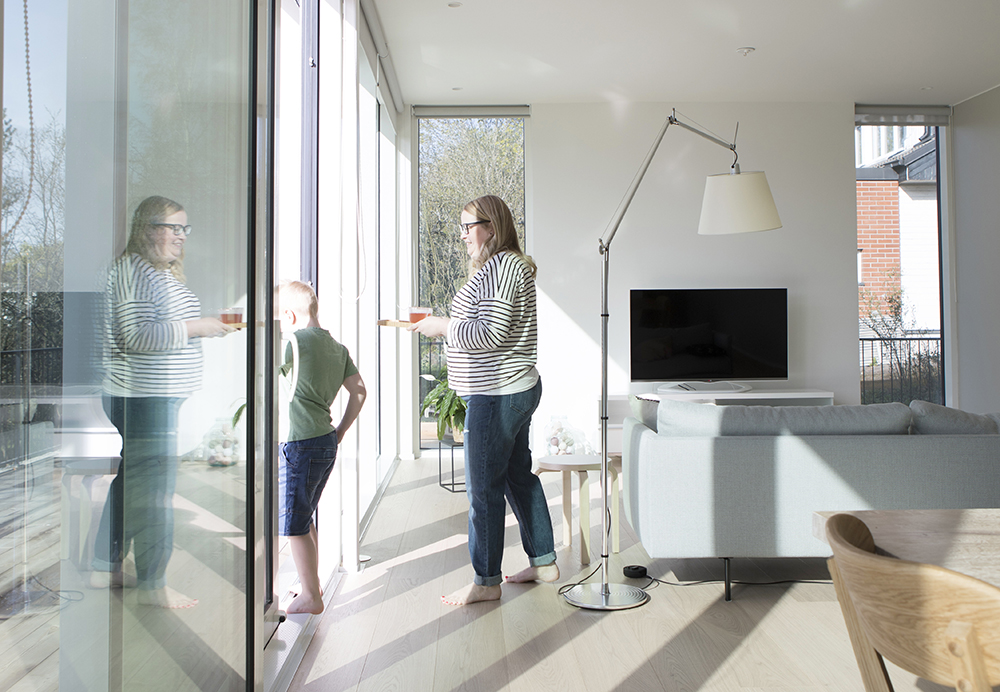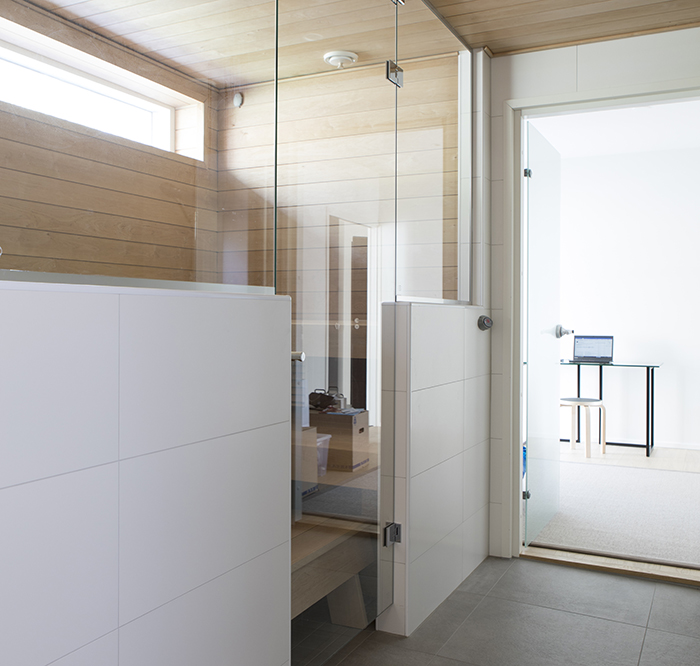The Turku-based family chose a modern ground source heat pump for their detached house, which always runs at optimum efficiency. This helps to save electricity and prolongs the technical life of the pump.

It is sometimes said playfully that a modern house warms up even with a hair dryer. However, this home in Pitkämäki, Turku, has been played with confidence. In the technical space of the newly completed hillside house, there is a central heating unit, a 6 kW ground source heat pump model Jämä Star RST Inverter.
The ground source heat pump works like a refrigerator, but conversely, that is, instead of cold, it produces heat. The sound level of the appliance is surprisingly quiet – even louder in the fridge.
The ground source heat pump produces heating water for two underfloor heating circuits, one in dry rooms and the other in damp rooms. In addition, the pump produces hot water.

The ground source heat pump heats two underfloor heating circuits, one of which is in damp areas. During the warm summer season, it is used alone.

The house’s ground source heat pump is Jäspi’s Jämä Star RST Inverter. In its compact size, it would have accommodated even a smaller technical space, as the floor space requirement is only about 0.8 square meters.
Solar and geoenergy from a heat well
The ground source heat pump retrieves the solar and geoenergy stored in the earth’s furnace from the heat well via a heat recovery fluid circulating in the collection pipe. The depth of the well hole drilled at the construction site, 150 meters, is based on precise calculations.
In connection with earthworks, the collection pipe laid at a depth of 1.5 meters would have become cheaper, but the required amount of collection pipe would not fit in the surface area of the 900 square meter plot.
The average annual efficiency of the heat pump, or SCOP, is 5.5. This means that with an input power of one kilowatt, the device outputs up to 5.5 kW. In terms of annual efficiency, the device is among the top in the market.
The slope house, built of ingots, has 155 square meters of heated space and has an energy class of C.
– I would believe that the annual electricity consumption for heating and hot water is in the order of 4,500 kilowatt hours and the total electricity consumption with lighting is less than 10,000 kilowatt hours, says the host of the house.

The combination of kitchen and living room is spacious and bright. The ground source heat pump helps to cool the house during the summer season.
Energy efficiency and ecology took the win
The decision about the heat pump as a form of heating was made quickly. The family also considered air-to-water heat, the total cost of which is usually about 30 percent cheaper than a ground source heat pump. However, there were good experiences of geothermal in the circle of acquaintances.
Above all, the couple wanted an option that is as energy efficient and ecological as possible from a climate change mitigation perspective. The eco-friendliness is enhanced by the designed solar panels, which can be connected to a ground source heat pump.
The ground source heat pump also controls the reasonableness of water use. The hot water setting can be set to luxury, normal or economy level.

On the wall opposite the ground source heat pump, a manifold, circulating water pumps for underfloor heating and a shunt valve are installed.
The family’s decision was also influenced by the positive effect of geothermal heat on the value of the property. When the family proportioned the cost of acquiring geothermal heat to the price of the house project, their share did not startle. The only downside to the heat pump was the making of a heat well, which the family feared would damage the yard and plot as well as disturb neighbors.
– Fortunately, the damage was minimal, and drilling took place in one day, when the plot was empty and the bedrock was just above the ground.
The heat pump adapts from frost to summer heat
At the same time, the large 16 square meter technical space at the end of the house is a hobby where you can study the wonders of heating physics.
– The unit has a speed-controlled compressor that always runs at optimum power. When power control is flexibly stepless thanks to the inverter, it saves electricity and extends technical life, the host says.
Thanks to the flexible stepless power control, the heat pump adapts well to different heating situations. This allows for minimal heating during the summer and, on the other hand, the utilization of the full heating potential in the winter frosts.
– In national terms, our house is lightly shaved with “surface gas” in the summer. In this case, the device only handles underfloor heating in damp rooms with a minimum power of 1.5 kilowatts. In winter, there is a situation on the other extreme, when heat is produced at the bottom of the pedal, ie at 6 kilowatts.

The simplified and natural light house has 175 square meters with carports. Concrete cast insulation blocks were supplied by Lakka Kivitalo.
Geothermal heat is also used to cool the house. When the temperature of the heat recovery fluid circulating in the heat well is 6-7 degrees all year round, it is cool enough for summer cooling. In this case, no separate cooling device is required, which is usually an air source heat pump.
Control and monitoring is handled even by telephon
The operation of the ground source heat pump is automated. The user can change the automation setting values and give it control commands from the control panel touch screen. If the meaning of a control has been forgotten, the device provides easy-to-understand instructions at the touch of a button.
Changing the settings is easy and quick to learn, depending on the family. Time control of heating and lowering of the room temperature takes place in an instant, for example before going on holiday. When traveling, the operation of the pump can be monitored and controlled with a mobile phone – the device comes standard with remote monitoring software. If a fault occurs in the device, the resident receives a message. Remote control costs about 25 euros a year.
Although the device operates for long periods on its own, it is advisable to check it at appropriate intervals on site or remotely. The message may be, for example, an acute need for maintenance. Almost always the user knows how to return the heat pump to normal operation, and it also naturalizes remotely. Advice and maintenance assistance is also available. The actual regular maintenance is the annual cleaning of the strainer.

